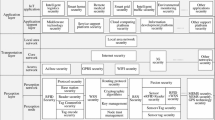Abstract
Internet Key Exchange version 2 (IKEv2) is taking the responsibility for distribution and management of reliable authentication key. IKEv2 can secure fast hand off, confidentiality of data, safe transmission, and multihoming to transmission node. In this paper, we designed and constructed the network based on real mobile node and experimented the modeling of IKEv2 protocol through the simulation. We analyzed the resetting of authentication key and re-exchange problem. And we experimented the effect that key exchange is affected by a limited bandwidth based on data analysis. To overcome delay time, we proposed multi-interface of node and analyzed performance and latency for authentication setting and exchange process. The simulation results show that re-authentication of key is impossible to reset because of limited bandwidth of network. Also, the use of proposed multi-interface can minimize key exchange latency that happened by hand off for IPSec transmission.














Similar content being viewed by others
References
Wang CY, Huang HY, Hwang RH (2011) Mobility management in ubiquitous environments. Pers Ubiquitous Comput 15(3):235–251
Kim J, Lu J, Hsu CH (2012) Advanced security technologies and applications for ubiquitous computing. Pers Ubiquitous Comput. doi:10.1007/s00779-012-0533-2
English C, Terzis S, Nixon P (2006) Towards self-protecting ubiquitous systems: monitoring trust-based interactions. Pers Ubiquitous Comput 10(1):50–54
Kent S, Atkinson R (1998) Security architecture for the internet protocol. RFC2401. http://www.ietf.org/rfc/rfc2401.txt
Arkko J, Devarapalli V, Dupont F (2004) Using IPsec to protect mobile IPv6 signaling between mobile nodes and home agents. RFC3776. http://www.ietf.org/rfc/rfc3776.txt
Han K, Mun H, Shon T, Yeun CY, Park JJ (2012) Secure and efficient public key management in next generation mobile networks. Pers Ubiquitous Comput 16(6):677–685
Dupont F (2005) Address management for IKE version 2. http://tools.ietf.org/html/draft-dupont-ikev2-addrmgmt-08
IEKv2 Mobility and Multihoming (Mobike) WG. http://tools.ietf.org/wg/mobike/
Lee Y, Lee GY, Kim HJ, Jeong CK (2012) Performance analysis of authentication and key distribution scheme for mobile multi-hop relay in IEEE 802.16j. Pers Ubiquit Comput 16(6):697–706
Kent S, Atkinson R (1998) IP authentication header. RFC 2402. http://www.ietf.org/rfc/rfc2402.txt
Kent S, Atkinson R (1998) IP encapsulating security payload (ESP). RFC 2406. http://www.ietf.org/rfc/rfc2406.txt
Kivinen T, Tschofenig H (2006) Design of the IEKv2 mobility and multihoming (MOBIKE) protocol. RFC4621. https://tools.ietf.org/rfc/rfc4621.txt
Johnson D, Perkins C, Arkko J (2004) Mobility support in IPv6. RFC3775. http://www.ietf.org/rfc/rfc3775.txt
Hagen S (2006) IPv6 essentials. O’Reilly Media, Sebastopol, CA
Miller MA, Miller PE (2000) Implementing IPv6: supporting the next generation internet protocols. Wiley, London
Wang W, Villaça RS, de Paula LB, Pasquini R, Verdi FL, Magalhães MF (2008) An architecture for mobility support in a next generation internet. In: Proceedings of the international conference on advanced information networking and application (AINA), pp 818–825
Linux FreeS/WAN. http://www.freeswan.org
NIST IPSec and IKE simulation tool (NIIST). http://www.antd.nist.gov/niist/
USAGI (UniverSAl playground for Ipv6) project. http://www.linux-ipv6.org/
MIPv6 for Linux. http://tldp.org/HOWTO/Mobile-IPv6-HOWTO/
SSFNet (scalable simulation framework network models). http://www.ssfnet.org
Kaufman C (2005) Internet key exchange (IKEv2) protocol. RFC4306. http://www.ietf.org/rfc/rfc4306.txt
Acknowledgments
Fundings for this paper was provided by Namseoul University.
Author information
Authors and Affiliations
Corresponding author
Rights and permissions
About this article
Cite this article
Lee, D.H., Kim, J.G. IKEv2 authentication exchange model and performance analysis in mobile IPv6 networks. Pers Ubiquit Comput 18, 493–501 (2014). https://doi.org/10.1007/s00779-013-0669-8
Received:
Accepted:
Published:
Issue Date:
DOI: https://doi.org/10.1007/s00779-013-0669-8




